【第七十八回目】
日本橋 神茂:日本橋・魚河岸の歴史を継ぐ「半ぺん・蒲鉾」の名店
Nihonbashi Kanmo: A famous hanpen and kamaboko store that inherits the history of Uogashi in Nihonbashi
Nihonbashi Kanmo: A famous hanpen and kamaboko store that inherits the history of Uogashi in Nihonbashi
| セインさん。今日は江戸時代、日本橋に魚河岸ができた頃から続く、半ぺん・蒲鉾の老舗「神茂」に伺います。 Thayne-san, today we’re going to Kanmo, an old hanpen and kamaboko store that has been open since Uogashi was established in Nihonbashi in the Edo Period. *hanpen / *kamaboko / *Nihonbashi / *Edo Period |
|
| 僕は、おでんが大好きなので、「神茂」の名前はよく知っています。食いしん坊ですから(笑)。でも、本店を訪ねるのは初めてです。 I love oden, so I know the name Kanmo wellーbecause I love to eat (laughing). But this is my first visit to the main store. *oden |
|
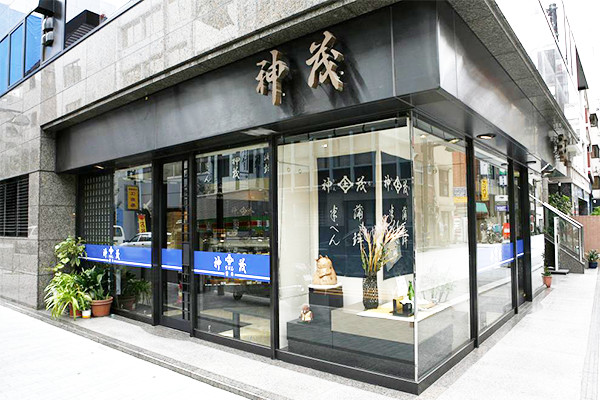 お店の写真 お店の写真[A photo of the store] |
|
| (井上) | こんにちは、セインさん、コンシェルジュさん。神茂の井上です。 Inoue: Hello, I’m Inoue from Kanmo. |
| 井上さん、こんにちは。まずは、お店の歴史から教えてください。 Hello, Inoue-san. First, please tell us about the history of this store. |
|
| (井上) | うちの初代は大坂の人で、明暦2年(1656)に江戸に出てきて漁業をしていたようです。やがて魚を加工して蒲鉾を作り始め、魚河岸があった日本橋に店を出したようです。 今、神茂の代名詞ともなっている半ぺんは、天和3年(1683)に5代目が、江戸幕府の重要な輸出品だったサメのヒレを取った残りの魚肉に目をつけたことに始まると伝えられています。 Inoue: The founder was apparently an Osakan who came to Edo in 1656 as a fisherman. Eventually, we began processing fish into kamaboko, and established a store in Nihonbashi where Uogashi is. We are told that hanpen, which is synonymous with Kanmo, began in 1683 when the 5th generation owner fixed his sights on the leftover fish meat from harvesting shark fins which were an important export of the Edo Shogunate. *Edo Shogunate |
| サメのヒレ、フカヒレですね。 Shark fins, fukahire, right? |
|
| (井上) | はい。当時からフカヒレは中国料理の高級食材として人気で、日本から中国に輸出されていました。そのため市場には大量のサメが出回っていたのですが、ヒレを取った残りは捨てられる運命でした。その魚肉で半ぺんを作ったところ評判になって、これが330年を超えて今に続いているんです。 Inoue: Yes. Shark fin has been popular as a delicacy in Chinese cuisine since those times, so they were exported from Japan to China. Because of that, there was a lot of shark circulating in the markets, but everything except the fins was destined to be thrown out. He decided to use the shark meat to make hanpen, and that has continued for over 330 years to the present. |
| すごい!当時は江戸の近くの海にもサメがいたんですね。 Wow! So there were sharks in the ocean near Edo at the time. |
|
| (井上) | 相模湾から江戸湾(東京湾)にかけてがサメの産卵場で、よく獲れたようです。 Inoue: The breeding ground for sharks extends from Sagami Bay to Edo Bay(Tokyo Bay), so it was easy to catch them. *Sagami Bay |
| 半ぺんに使うサメの種類は何ですか? What kind of shark is used in hanpen? |
|
| (井上) | うちではアオザメとヨシキリザメを使っています。アオザメはおいしいのですが、漁獲量が少ないため値段が高い。それで、代わりにタラを使うお店も多いのですが、うちでは昔からの原料と製法にこだわり続けています。アオザメが4割、ヨシキリザメが6割、この割合も変えていません。毎日、新鮮なサメが気仙沼や焼津など各地の漁港から冷蔵で届きます。 アオザメは若くて脂ののった70キロクラスのもの。これが、神茂の半ぺんの、味の土台です。 一方、ヨシキリザメは身が柔らかいので、ふっくらと空気を抱き込んでくれます。どちらもきれいに血合いを取り除いて下ごしらえし、ミンチにしてから漉し機を通して筋を取り、塩や山芋、卵白などを加えて、石臼ですり上げます。 今、ちょうど地下にある工場でその作業をしていますが、ご覧になりますか? Inoue: At our store, we use mako shark and blue shark. Mako shark is tasty, but they are expensive because not many are caught. Because of that, there are a lot of stores that use codfish instead, but our store has always been particular about the ingredients and our methods. The ratio has always been 40 percent mako shark to 60 percent blue shark. Every day, fresh chilled shark arrives from Kesennuma, Yaizu and all the other fishing ports. The mako shark are young, fatty specimens weighing around 70 kilograms. That’s the foundation for the flavor of Kanmo’s hanpen. On the other hand, the meat of the blue shark is tender, so it holds air and fluffiness. We carefully prepare it by trimming away the dark meat, mince it and pass it through a sieve to remove the tough bits, add salt, yam and egg white, and then grind it on a stone mortar. Right now, we are doing that work in the factory in the basement. Would you like to see? *mako shark / *blue shark |
| ぜひ! Of course! |
|
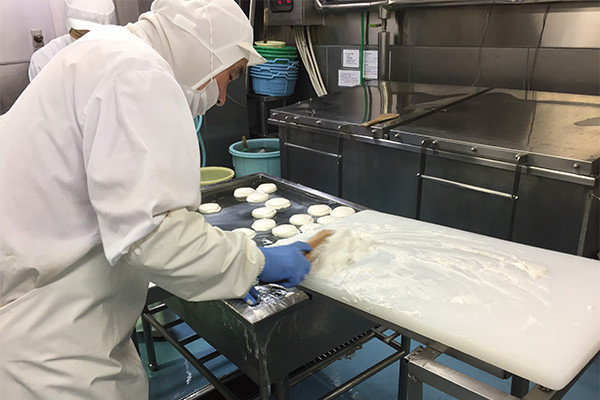 本店の地下にある製造工場 本店の地下にある製造工場[The factory in the basement of the main store.] |
|
| ウワーッ、サメの身って真っ白で、きれいですね! 材料をすり合わせるのに、石臼を使っているんですね。 Wow, shark meat is so white and beautiful! You use a stone mortar to grind the ingredients together, right? |
|
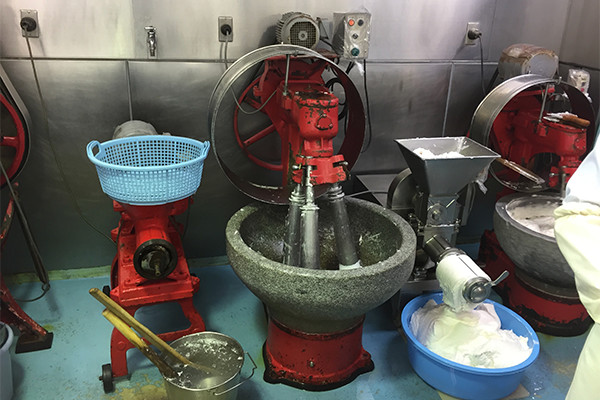 サメの肉に山芋や卵白などを混ぜて、石臼ですり上げる サメの肉に山芋や卵白などを混ぜて、石臼ですり上げる[Shark meat is mixed with yam and egg whites and ground on a stone mortar.] |
|
| (井上) | すっていると熱をもってくるので、石臼を使います。すると、魚肉の細胞が壊されにくいので旨みが残る。これも昔の人の知恵ですね。そしてだいたい45分程すったら、目の細かい漉し機でこしてキメを整え、手作業で型取りして茹で上げます。 いま、こちらでは職人が型取りをしています。木べらを使って型に盛り、回しながら叩いて成型するのですが、この工程で身が膨らみます。 Inoue: We use a stone mortar because it heats up during the grinding process. Because it doesn’t destroy the cells in the shark meat, the flavor remains. This is some knowledge passed down through the generations. Grind it for around 45 minutes and pass it through a fine sieve, then put it into molds by hand and boil it. An employee is molding the paste now. They put it into the mold with a wooden spatula and hit it while swirling it around. This process fluffs it up. |
| リズミカルでスピード感があってすごーい! セインさんもトライしてみますか? It’s so rhythmic and speedy! Would you like to try it, Thayne-san? |
|
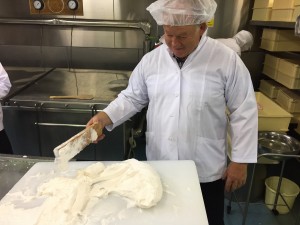 セインさん、型取りに挑戦 [Thayne-san tries the molding process.] |
|
| 丁寧に二度濾したり、ふっくらと空気を含ませるように手取りをしたりと、半ぺん一つとっても、歴史を重ねて築き上げてきた知恵と技があるんですね。 Straining it twice carefully and forming it by hand to incorporate air and make it fluffy. Hanpen is an example of knowledge and techniques built up through a long history. |
|
| 工場を見せていただいてよかった。清潔な場所で、丁寧にして無駄なく、熟練の技で作られているのがよくわかりました。 Thank you for showing us the factory. It’s easy to see that it’s a clean place where nothing is wasted and things are made with skill. |
|
| (井上) | 無駄なく、と言えば、半ぺんを作る途中で取り除いたアオザメの皮で作る「煮こごり」も人気なんですよ。 Inoue: Speaking of wasting nothing, the nikogori made from the mako shark skin left over when making hanpen is popular too. |
| セインさん。神茂は、手取り半ぺんをはじめとして蒲鉾や伊達巻、おでんに大活躍する揚げ物などいろいろな商品を作っていますが、「煮こごり」も隠れた大人気商品なんです。 Kanmo makes a lot of products, starting with tedori hanpen, kamaboko, datemaki, and lots of fried foods that are often used in oden, but nikogori is an overlooked popular item. |
|
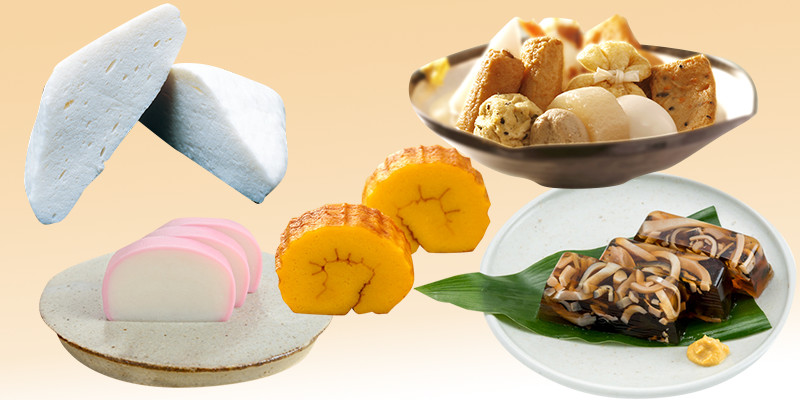 「手取り半ぺん」「蒲鉾」「伊達巻」「おでん種」「煮こごり」 「手取り半ぺん」「蒲鉾」「伊達巻」「おでん種」「煮こごり」[Photo: Tedori hanpen, kamaboko, datemaki, oden ingredients, nikogori] |
|
| この店にはアイデアマンの血が流れているんですね。先代や先々代などはどんな方だったんですか? This store really seems to have the heritage of a visionary, doesn’t it? What was the previous master, and the one before him like? |
|
| (井上) | 父は真面目で、よく仕事をする人でした。祖父は山が好きで、東京登歩渓流会というところに所属して自分でも山を楽しみながら、日本の登山界のためにいろいろ尽力したようです。『風雪のビバーク』『氷壁』といった山岳を舞台とした名著にも名前が出てきます。 Inoue: My father was a serious man who worked a lot. My grandfather loved the mountains, and worked hard for the hiking community in Japan while enjoying the mountains himself as a member of the Tokyo Toho Keiryukai. His name is in famous books set in the mountains such as “Fusetsu no Bibaku” and “Hyouheki.” |
| こういう歴史のあるお店には、いろいろな当主がいて、でもしっかり引き継いでいらっしゃるんですね。 井上さんご自身は、この家業を継いで仕事をしてこられて、今どんなことを考えておられるのですか? In a store like this with a history, there have been a lot of different masters, but traditions and skills have been passed down without a break. Inoue-san, what do you personally think now about inheriting this business? |
|
| (井上) | 単純ですが、自分が作ったものが売れる、ということに幸せを感じています。私は大学を出たあとしばらく大手のスーパーマーケットに勤めてから家業に就いたのですが、ちょうど日本全体で景気が落ち込んでいて、うちも大変な時期でした。 そこで経費の削減や商品の見直しなどをしながら懸命に働いたわけですが、そうした努力がちゃんと結果に反映されていくのが純粋に嬉しくて、やりがいを感じました。 Inoue: It might sound simple, but I feel very happy about being able to sell things I’ve made. I came here after working in a major supermarket for a while after I graduated from college, and that was just as the Japanese economy took a downturn, so it was a difficult period for us. I worked hard to reduce expenses and review our products, and seeing that work reflected in the results simply makes me happy, and it makes me feel like my efforts paid off. 神茂には、「商売はあまり大きくしてはいけない。目の届く範囲で、いい品を作ることが一番大事」だという先人の言葉が伝えられているんですが、私も、自分の役目は日本の伝統文化を次につなげていくことができれば、それでいいかなと思っているんです。 |
| つまり、いま天職に就いているわけですね! In other words, you’ve really found your vocation! |
|
| 今日は長い時間ありがとうございました! Thank you very much! |
|
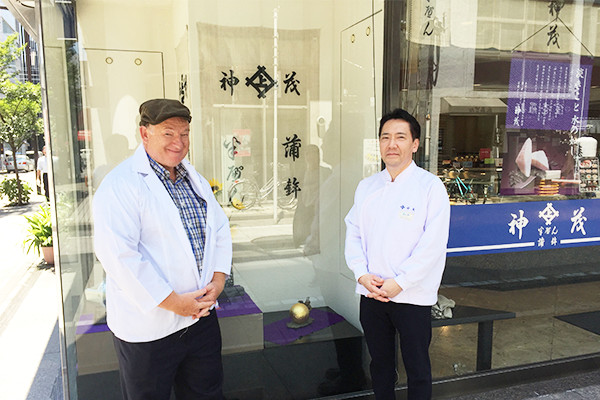 |
|
| 日本橋神茂ホームページはコチラ | |
| (文)太田美代 (英訳)デイビッド・A・セイン |
 1959年、米国生まれ。証券会社勤務を経て来日し、翻訳・通訳など多岐にわたって活躍。豊富な教授経験を生かし、数多くの英語関係書籍を執筆。近著に『日本人のチョットへんな英語』(アスコム)、『超入門シャドーイング』(主婦の友社)、日本人が使いすぎる英語(PHP文庫)など多数。 下町の魅力に魅了され、自身が代表を務める英語関連のコンテンツ会社のエートゥーゼットのオフィスを根津に構えている。英会話本の執筆をしながら、東京・文京区根津と春日にあるエートゥーゼット英語学校の校長も務める。 http://www.smartenglish.co.jp/
1959年、米国生まれ。証券会社勤務を経て来日し、翻訳・通訳など多岐にわたって活躍。豊富な教授経験を生かし、数多くの英語関係書籍を執筆。近著に『日本人のチョットへんな英語』(アスコム)、『超入門シャドーイング』(主婦の友社)、日本人が使いすぎる英語(PHP文庫)など多数。 下町の魅力に魅了され、自身が代表を務める英語関連のコンテンツ会社のエートゥーゼットのオフィスを根津に構えている。英会話本の執筆をしながら、東京・文京区根津と春日にあるエートゥーゼット英語学校の校長も務める。 http://www.smartenglish.co.jp/







